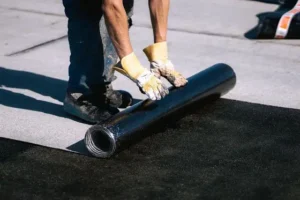Introduction
TPO (Thermoplastic Polyolefin) waterproofing membranes have become one of the most popular choices for roofing and waterproofing applications due to their durability, energy efficiency, and cost-effectiveness. This article provides a clear overview of standard TPO waterproofing membrane specifications, helping builders, architects, and procurement managers choose the right product for their projects.
1. Material Composition
-
Base Material: Thermoplastic polyolefin (TPO), a blend of polypropylene and ethylene-propylene rubber.
-
Reinforcement: Polyester fabric or fiberglass scrim for added strength and dimensional stability.
-
Surface Finish: Smooth or textured white/gray membrane with UV-resistant coating.
2. Standard Thickness Options
-
1.2mm (45 mils): Ideal for low-cost or temporary applications.
-
1.5mm (60 mils): Industry standard for commercial roofing; balances cost and performance.
-
2.0mm (80 mils): Offers enhanced durability and weather resistance for demanding environments.
3. Roll Size & Coverage
-
Standard Widths: 1.0m, 2.0m, 3.0m (customized sizes available).
-
Length per Roll: 20m or 30m rolls commonly available.
-
Coverage Area: Ranges from 60 m² to 90 m² depending on thickness and roll size.
4. Physical & Mechanical Properties
| Property | Specification |
|---|---|
| Tensile Strength | ≥ 800 N/50mm |
| Elongation at Break | ≥ 450% |
| Tear Resistance | ≥ 250 N |
| Dimensional Stability | ≤ ±2% |
| Low Temperature Flexibility | ≤ -40°C |
| Water Vapor Permeability | ≤ 1.0 g/m²·24h |
| UV Resistance | ≥ 5000 hours (QUV test) |
5. Installation Methods
-
Hot-Air Welding: For strong, seamless joints.
-
Fully Adhered: With compatible adhesives.
-
Mechanically Fastened: Ideal for large-scale commercial roofing.
-
Ballasted Systems: Common for flat roofs with gravel ballast.
6. Performance Features
-
UV Resistance: Excellent resistance to sun exposure and thermal aging.
-
Chemical Resistance: Resistant to acids, alkalis, and industrial pollutants.
-
Eco-Friendly: 100% recyclable, low VOCs, contributes to LEED credits.
-
Reflectivity: High solar reflectance (white TPO) reduces cooling load and energy costs.
7. Typical Applications
-
Commercial and industrial flat roofing
-
Green roofing systems
-
Waterproofing for tunnels and underground structures
-
Waterproofing layer for prefab and modular construction
Conclusion
TPO waterproofing membranes offer an excellent combination of performance, durability, and environmental benefits. When selecting a TPO membrane, it’s critical to consider its specifications in relation to your project’s specific requirements. Whether you’re working on a new construction or a roofing renovation, understanding these key specifications ensures a longer-lasting, more efficient waterproofing solution.

Contact Us
For more information or to inquire about our waterproof floor paint solutions, feel free to get in touch with us. We’re here to help!
- Phone: +86 138 6365 6701
- Email: Huafengwaterproof@gmail.com
- WhatsApp: +86 138 6365 6701
We look forward to assisting you with all your waterproofing needs!






